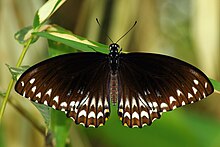Chilasa clytia
| Chilasa clytia | ||||||||||||
|---|---|---|---|---|---|---|---|---|---|---|---|---|

Chilasa clytia f. dissimilis , underside of the wing |
||||||||||||
| Systematics | ||||||||||||
|
||||||||||||
| Scientific name | ||||||||||||
| Chilasa clytia | ||||||||||||
| ( Linnaeus , 1858) |
Chilasa clytia ( synonym : Papilio clytia ) is a butterfly from the family of knight butterflies (Papilionidae) and the subfamily of swallowtails (Papilioninae)in Southeast Asia. The first describer Carl von Linné named many of the swallowtail species after people from Greek mythology , so in this case, too, the specific epithet was chosenafter Clytia , a lover of Apollo .
features
The wingspan of the moth is 80 to 110 millimeters. A tail process is missing at the anal angle of the hind wings. There is no sexual dimorphism between the sexes , males and females have the same markings. There are different forms. In the form of clytia , all wings are predominantly black-brown to black on the upper side. Only along the edge of the wing do white spots stand out. The form dissimilis shows an alternating black and white striped pattern on the upper sides of the wings. The drawing of the undersides resembles the upper sides, but mostly shows a yellowish to reddish row of spots on the edge of the hind wings.
Similar styles and mimicry
The drawing of the shape clytia resembles Euploea core while the shape dissimilis resembles the moths of Tirumala limniace . Both cases are typical examples of mimicry . The non-poisonous moths of Chilasa clytia benefit from the fact that they look like the poisonous similar species and are therefore avoided by predators.
Pre-imaginal stages
The egg is round, rough, shiny and orange-yellow in color.
In the first stages, the caterpillars are brown-white in color; fully grown, yellowish, greenish or whitish specimens appear, each of which shows more or less strong black drawings. They are then provided on the entire surface of the body with pointed, black tubercles , which are colored bright red at the base. To deter predators, the caterpillars are able to turn out a yellowish to bluish osmaterium .
The pupa has an elongated shape, is predominantly light brown in color and has a hump-like outgrowth behind the head. It is attached to branches as a belt doll and looks deceptively like a branch that has broken off irregularly at one end. The last segment is designed in such a way that the doll is not attached at points, but rather looks as if it has grown out of the branch.
Distribution, subspecies and habitat
The species occurs in India , Sri Lanka , Thailand , Malaysia , Myanmar , Laos , Cambodia , in southern China as well as on Sumatra , Borneo , Sulawesi , Timor , Singapore and the Philippines . 13 subspecies are currently classified in the various occurrence areas . Chilasa clytia prefers to colonize rainforests up to an altitude of 800 meters.
Way of life
The moths mainly fly during the monsoon season between June and September and occasionally afterwards in the months of October to December. The eggs are laid singly or in small groups on top of young leaves or twigs of the food plant. They need three days for the caterpillars to hatch, which then first eat the egg shell and then go through five stages until pupation. The moths hatch after about 12 days of pupal rest. This visit for nectar intake like flowers, such as lantana ( Lantana ) or suck sometimes in number at the bottom of damp Erdstellen to accommodate fluids and minerals. The caterpillars feed polyphagously on the leaves of various laurel plants (Lauraceae), such as Cinnamomum , Litsea or Alseodaphne species.
Individual evidence
- ↑ John L. Heller: Classical mythology in the Systema Naturae of Linnaeus , The Johns Hopkins University Press, Vol. 76, 1945.
- ↑ Markku Savela: Tanaecia Butler (1869) - distribution. In: Lepidoptera and some other life forms. Retrieved December 8, 2018 .
- ^ Butterflycircle Butterflies of Singapore
Web links
- learnaboutbutterflies - Common Mime at Butterflies of India







